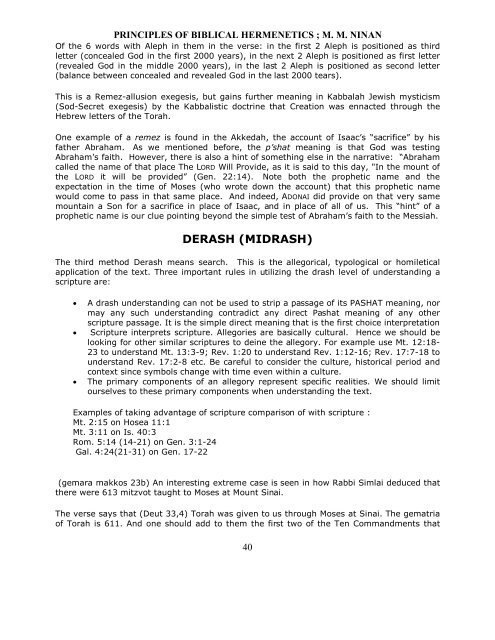Biblical Hermeneutics
You also want an ePaper? Increase the reach of your titles
YUMPU automatically turns print PDFs into web optimized ePapers that Google loves.
PRINCIPLES OF BIBLICAL HERMENETICS ; M. M. NINAN<br />
Of the 6 words with Aleph in them in the verse: in the first 2 Aleph is positioned as third<br />
letter (concealed God in the first 2000 years), in the next 2 Aleph is positioned as first letter<br />
(revealed God in the middle 2000 years), in the last 2 Aleph is positioned as second letter<br />
(balance between concealed and revealed God in the last 2000 tears).<br />
This is a Remez-allusion exegesis, but gains further meaning in Kabbalah Jewish mysticism<br />
(Sod-Secret exegesis) by the Kabbalistic doctrine that Creation was ennacted through the<br />
Hebrew letters of the Torah.<br />
One example of a remez is found in the Akkedah, the account of Isaac’s “sacrifice” by his<br />
father Abraham. As we mentioned before, the p’shat meaning is that God was testing<br />
Abraham’s faith. However, there is also a hint of something else in the narrative: “Abraham<br />
called the name of that place The LORD Will Provide, as it is said to this day, "In the mount of<br />
the LORD it will be provided” (Gen. 22:14). Note both the prophetic name and the<br />
expectation in the time of Moses (who wrote down the account) that this prophetic name<br />
would come to pass in that same place. And indeed, ADONAI did provide on that very same<br />
mountain a Son for a sacrifice in place of Isaac, and in place of all of us. This “hint” of a<br />
prophetic name is our clue pointing beyond the simple test of Abraham’s faith to the Messiah.<br />
DERASH (MIDRASH)<br />
The third method Derash means search. This is the allegorical, typological or homiletical<br />
application of the text. Three important rules in utilizing the drash level of understanding a<br />
scripture are:<br />
• A drash understanding can not be used to strip a passage of its PASHAT meaning, nor<br />
may any such understanding contradict any direct Pashat meaning of any other<br />
scripture passage. It is the simple direct meaning that is the first choice interpretation<br />
• Scripture interprets scripture. Allegories are basically cultural. Hence we should be<br />
looking for other similar scriptures to deine the allegory. For example use Mt. 12:18-<br />
23 to understand Mt. 13:3-9; Rev. 1:20 to understand Rev. 1:12-16; Rev. 17:7-18 to<br />
understand Rev. 17:2-8 etc. Be careful to consider the culture, historical period and<br />
context since symbols change with time even within a culture.<br />
• The primary components of an allegory represent specific realities. We should limit<br />
ourselves to these primary components when understanding the text.<br />
Examples of taking advantage of scripture comparison of with scripture :<br />
Mt. 2:15 on Hosea 11:1<br />
Mt. 3:11 on Is. 40:3<br />
Rom. 5:14 (14-21) on Gen. 3:1-24<br />
Gal. 4:24(21-31) on Gen. 17-22<br />
(gemara makkos 23b) An interesting extreme case is seen in how Rabbi Simlai deduced that<br />
there were 613 mitzvot taught to Moses at Mount Sinai.<br />
The verse says that (Deut 33,4) Torah was given to us through Moses at Sinai. The gematria<br />
of Torah is 611. And one should add to them the first two of the Ten Commandments that<br />
40


















